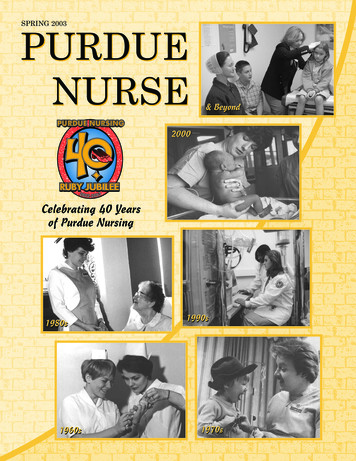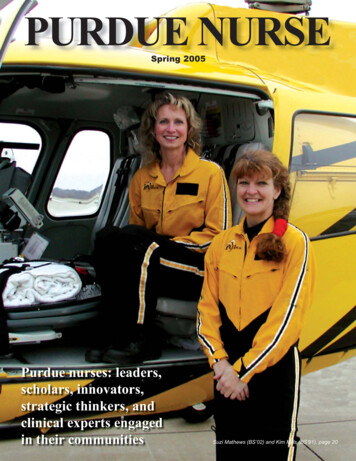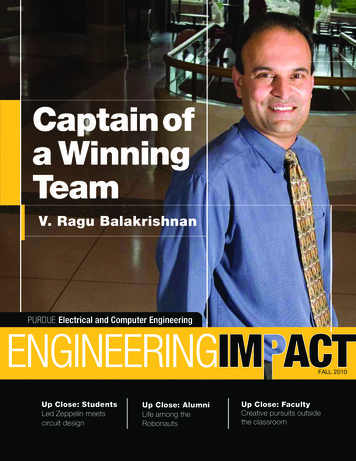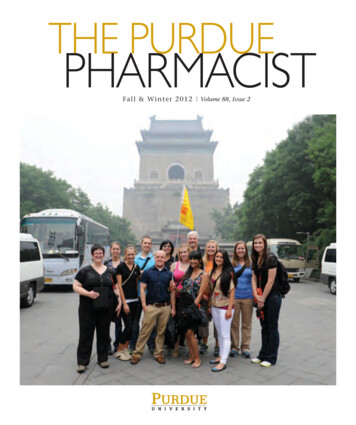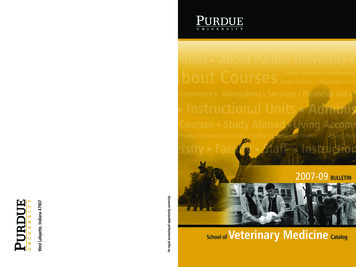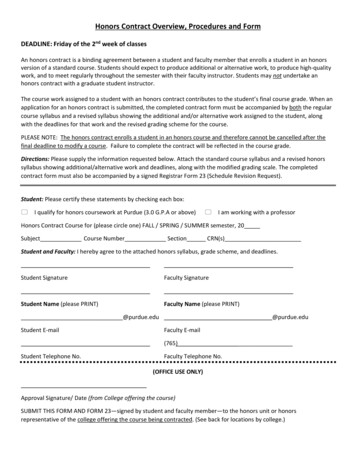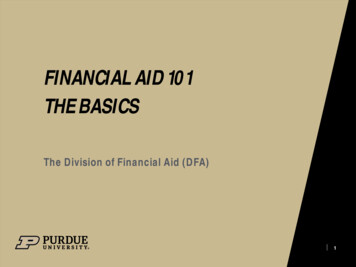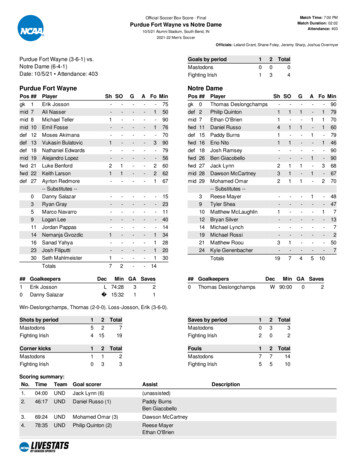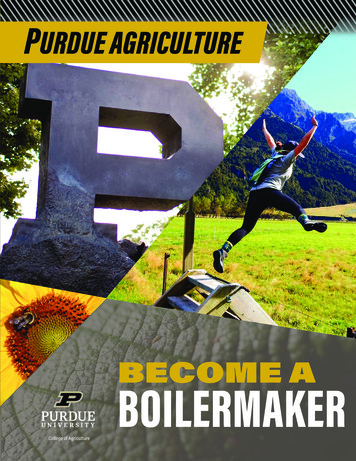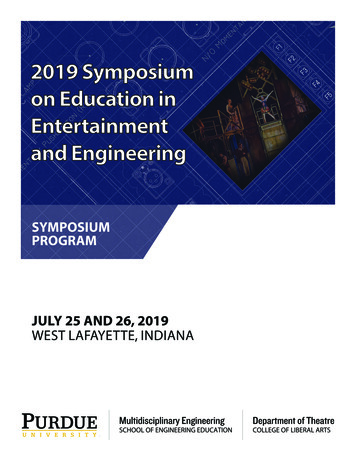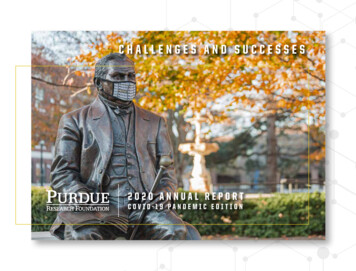
Transcription
CHALLENGES AND SUCCESSES2020 ANNUAL REPORTCOVID-19 PANDEMIC EDITION
ADVANCING THE MISSIONOF PURDUE UNIVERSITYPurdue Research Foundation supportsPurdue University’s land-grant mission by helpingthe University improve the world through itstechnologies and graduates. Patenting and commercializing Purdue technologies Building places to encourage innovation, invention,investment, commercialization and entrepreneurship Making equity available to students to finance theirPurdue educationsPurdue Research Foundation also owns and managesthe Purdue Research Park, several satellite technologyincubators and works to acquire real estate forUniversity expansions.Purdue Memorial Union seen through theeastern entrance to campus.1
TABLE OF CONTENTS4-5 Message from our President6-7 Our History8-9 COVID-19 First Actions10-15Serving Our Mission: Protect Purdue16-17Back a Boiler – ISA Fund18-23Discovery Park District24-29Discovery Park District: A Connected Community30-33Economic Development Office34-35Alliances and Placemaking36-43Purdue Foundry44-49Office of Technology Commercialization50-51Information Systems52-53Human Resources54-55Marketing and Communications56-57Purdue for Life Foundation58 Office of Investments59-61Accounting and Financial Reporting62-65Voices From the Pandemic66 Special Thanks67 Administration68 Editor’s Note and Production TeamConvergence Center for Innovation and Collaboration isprivate industry's front door to Purdue University.3
MESSAGE FROM BRIAN EDELMANDespite the challenges of the COVID-19 pandemic, theFoundation saw yet another incredible year of successand growth. We also laid a strong base to advance ourinitiatives through 2021 even as the pandemic continuesto invade our lives and well-being.When the famed Waterford Apple landed at midnight in New York City’sTime Square to usher in 2020, it is realistic to say that not a single soulcould have predicted how a global pandemic would change nearly everyaspect of our lives.As COVID-19 started to take its grip on Indiana and the nation, our stellarteam at the Purdue Research Foundation and our partners at PurdueUniversity prepared to make big changes to address this challenge. Theycertainly rose to the occasion!One of our first initiatives was the formation of the Remote Working WellTeam to expedite a smooth and successful transition for employees to workfrom home.4Brian Edelman is President of the Purdue Research Foundation.Throughout this year, every single area of the Foundation quickly changeddirection with a focus of staying safe while advancing our goals. Thosedepartments include Accounting and Financial Reporting; EconomicDevelopment Office; Facilities and Real Estate; Finance; Human Resources;Information Systems; Investments; Marketing and Communications;Office of Technology Commercialization; Placemaking; Purdue Foundry;Purdue Research Park and Economic Development; and Purdue for LifeFoundation.
As a special thanks of recognition to the entire Purdue Research Foundation team who faced the challenge of COVID-19 together, we want to celebrate our PRF “family” byincluding their names and faces throughout this annual report. Their photos are included on their respective departmental pages. Here are my departmental members:David Broecker, Gary Cottingham, Bill Fox, Troy Hege, Brandee Sommer.I could not be more proud of the PRF team. Throughout 2020, we cametogether and took care of each other as we continue to do so. The successes of our team could fill a book. Here are just a few: The Foundation directly served the University during this pandemicby helping to turn an animal testing lab in the Purdue College ofVeterinary Medicine into a COVID-19 testing lab.Our team also worked to turn former graduate student housing ownedby the Foundation into a health, isolation and quarantine facility forstudents and others in need of such a space.Purdue’s commercialization ecosystem, led by the Office ofTechnology Commercialization, generated significant growth throughpatent applications, issued patents, technology disclosures, startupsand licensing deals.The Purdue Foundry saw another great year for startup creation,including several startups with work related to the pandemic andtechnologies to help those impacted by the coronavirus. The Foundation’s Economic Development and Placemaking teamsadjusted to major changes to turn 2020 into one of our best yearsever. We continue to grow Discovery Park District into an innovativeenvironment full of opportunities.Our Finance and Investment teams worked tirelessly to keep our teamat full strength during a time of employment uncertainty for manybusinesses and maintained solid financial strength for the Foundationand the University endowments.2020 has been filled with uncertainty, tragedy and triumph, both here athome and across the globe. It has been a year marked by challenge andchange – for communities, families and workplaces.Yet, with all the challenges this year has brought, the Foundation and itspartners saw great progress across our pan-Purdue ecosystem. You canread more highlights of these successes in this annual report, where youwill find stories about innovative technologies, robust startups, excitingeconomic development opportunities and much more.5
PURDUE RESEARCH FOUNDATIONAGELESS CHALLENGESJust as the founders of the Purdue Research Foundationhad the fortitude and vision to create the Foundation in1930, the same year America’s Great Depression crippledthe country, the leaders of the Foundation continuedto advance its mission throughout the 2020 COVID-19pandemic.As the coronavirus tookhold across the globe,America faced its owncrippling through thetragic loss of life andwell-being. The economyslowed to a crawl,educational institutionsDavid Ross (left) and Josiah Lilly (right) founded Purduefrom K-16 closed,Research Foundation in 1930.restaurants and otherpublic gathering places closed, even religious services, a primary right inAmerica’s Constitution, were ordered not to convene in large groups.6Neil Armstrong earned a bachelor's degree fromPurdue's School of Aeronautics and Astronautics in 1955.Through it all, the Foundation’s team worked remotely to meet its 2020goals and added new emergency measures to provide Purdue Universitywith assistance throughout the year and continue initiatives already inprogress.
These projects include: Remote Working Well Team: Reimagining the Employee Experience.COVID-19 testing: On-campus testing ability for the coronavirus thathelped bring Purdue students back to campus in the Fall of 2020.Quarantine space: Demolition plans for the Purdue Village were put onhold to provide 900 individual living spaces where students and othersexposed or diagnosed with COVID-19 could quarantine or isolate.Purdue for Life Foundation: Creation of a new organization uniting thePurdue Alumni Association and the University Development Officeunder the Foundation’s umbrella.Above: Purdue Research Park today (left) and in 1963 (right).Below: Senator Birch Bayh and Ralph Davis.More information about these initiatives are in this report.Our founders, David Ross, a prolific Indiana inventor, and Josiah Lilly,president of Eli Lilly and Co., each donated 25,000 to establish the PurdueResearch Foundation. They also were individuals who lived through the 1918influenza pandemic (H1N1 virus). About 500 million people, or one-third ofthe world’s population, became infected with this virus. Worldwide, at least50 million people died with about 675,000 deaths occurring in the UnitedStates.While it is too early to finalize the data for the 2020 COVID-19 pandemic, itis safe to say that Ross and Lilly would have approved of the way PurdueUniversity and Purdue Research Foundation managed and still advancedthe mission that they established in 1930.7
COVID-19 FIRST ACTIONS:REMOTE WORKING WELL TEAMREIMAGINING THE EMPLOYEE EXPERIENCEIt is important to recognize that no matter where aperson works, they need the tools and support to continueto innovate and produce while being cognizant thatwhat works for one person may not necessarily work foranother. Each team member has different challenges,and providing them with achievable goals and the rightassets to perform can lead to success for them and theFoundation.One of the Foundation’s first actions in response to the anticipatedmagnitude of the pandemic was to form the Remote Working Well Team.This Team manages the responsibility of directing the assistance, guidanceand resources that team members need to reach performance objectiveswhile being respectful of their personal lives and challenges.The goal of the Team is to identify ongoing, fluctuating challenges andcreate solutions for remote workers and for those employees whosepositions require them to be physically in their respective on-site workareas.8Purdue Research Foundation's Remote Working Well Committee:Breanna Benn, Deanna Bush, Ed Johnson, Wade Lange,Alicia South-Hurt, Barb Tyner.
AREAS OF CONCENTRATION Work-Life IntegrationCommunicationIT Adaption ResourcesTouchpoints for FutureAssistanceThe Team is comprised of individuals from various departmental areas.Members are Breanna Benn, Physical Facilities and Real Estate; DeannaBush, Placemaking; Ed Johnson, Information Systems; Wade Lange, PurdueFoundry; Alicia South-Hurt, Marketing and Communications/EconomicDevelopment; and Barb Tyner, Human Resources.As anticipated, technology resources remained paramount for most remoteworkers and the Foundation’s Department of Information Systems made itwork by finding new ways to remotely update or fix technological systemsand find ways for team members to digitally meet using Microsoft Teams,WebEx and other communication platforms.Physical facilities has the responsibility of keeping the Foundation’s 70-plusbuildings sanitized and ensuring that safety protocols as outlined by theState of Indiana and CDC recommendations are followed in all facilities.Other areas required just as much attention such as frequent andtransparent communication, flexibility in work schedules, respect for teammembers and the unknown personal challenges they face, and maintainingrelationships with internal and external partners all while working to meetthe Foundation's goals.The staff received virtual opportunities to participate in mental healthwebinars and yoga sessions as an initiative to focus on wellness andmindfulness during the pandemic.REMOTE WORKING WELLEMPLOYEE SURVEY RESULTSThe Remote Working Well Team has conductedsurveys to gauge employee satisfaction with theFoundation's tools and response.95%90%98%90%RESPONDED THAT REMOTEWORK TOOLS SUPPORTEDTHEIR WORK WELLSAID THEIR ENTHUSIASMFOR WORK WAS THE SAMEOR HIGHERKNEW WHAT WASEXPECTED OF THEMEVERY DAYPREFER A REMOTE ORHYBRID WORK ENVIRONMENTIN THE FUTURE9
SERVING OUR MISSIONPROTECT PURDUE: TENANTS AND VISITORSThe Foundation manages more than 1,500 acres and75-plus buildings in multiple locations around the Stateof Indiana where thousands of students, faculty, tenants,entrepreneurs and others live, work, play and learn.Keeping these people safe throughout the pandemic was,and continues to be, a primary goal.In the early days of COVID-19, Rich Michal, Vice President and ChiefFacilities Officer, worked daily with Jeremy Slater, Assistant Vice Presidentof Real Estate and Facilities, Jason Yoder, Senior Operations and ProjectManager, and many others to make and keep the buildings safe andfunctional.“It’s been a huge task, and my team has worked on-site the whole time,”Yoder said.Breanna “Bre” Benn, Client Communication and Engagement Manager,works on the front lines in the Herman and Heddy Kurz Purdue TechnologyCenter, the Foundation’s administration building.10Jason Yoder and Breanna Benn at the front desk of the Kurz PurdueTechnology Center in Purdue Research Park.“My job is to connect with visitors and tenants in the buildings and helpthem with whatever they need. This has certainly been a different kind ofyear, but I have gotten closer to the tenants. People want and need personalinteraction and even with the safety glass and social distancing, it hasworked. In fact, I’ve even gotten closer to tenants in other buildings as they
““Our tenants faced their own challengesthroughout the past year and we have doneeverything we can to keep them safe andwe followed all CDC guidelines. Communicatingwith them on a regular basis also is pivotal.”RICH MICHALVICE PRESIDENT AND CHIEF FACILITIES OFFICERreach out to me,” she said. “Team-wise, we did a lot of cross-training andI’ve learned what other areas like IT and Finance do. My physical facilitiescolleagues certainly help me a lot. We’re all helping each other.”Like nearly all buildings during this time, freestanding hand sanitizerswere placed in the entrances of facilities, facial masks became mandatory,clear acrylic glass was placed in visitor reception areas, and sanitation offrequently touched areas are just a few of the health and safety precautionstaken.“One of the challenges was to increase air purification processes. We’vedone this is by running the HVAC systems 24/7 which increased the intakeof outdoor air into the building,” Yoder said. “We also replaced the numerousroof-top air filters more frequently and conducted regular testing.”Other safety actions and processes include: Placing footholds on interior doors to create “hands-free” opening.Increasing computerized control systems to identify and repair issuesimmediately.Working with the USPS to create P.O. Box slots for tenants to reducehandling and sorting of mail.Brice Turpin, Assistant Facilities Manager, replaces HVAC filtersat the Convergence Center for Innovation.11
SERVING OUR MISSIONPROTECT PURDUE: COVID-19 TESTING AND SAFETYThousands of K-12 and higher education institutionsacross the country announced in late spring of 2020 thatthey would continue with remote learning in the fall dueto COVID-19.Purdue University was not one of those.Critical to the success of this bold prediction was the means to teststudents, faculty and staff for the coronavirus on a regular basis and as away to track the virus and prevent it from spreading. In those early days ofthe pandemic, testing ability for the virus was limited and in high demandand a growing consensus was to just stop everything and wait until the“virus went away.”Shops, restaurants, bars, governmental facilities and many otherestablishments had closed with no information on when or at what capacitythey would be able to reopen. People stayed in their homes, and when theydid venture out they wore masks, glasses and other protective gear andmaintained a social distance of six-feet apart from each other.In preparation of students’ return to campus in the fall, Purdue’s coronavirustesting ability became an important early initiative established in12The Animal Disease Diagnostic Laboratory performsPolymerase Chain Reaction (PCR) tests for COVID-19.partnership among Purdue University College of Veterinary Medicine,Purdue Research Foundation, the Indiana State Department of Healthand multiple Indiana hospitals.David Broecker, Chief Innovation and Collaboration Officer for theFoundation and initial Implementation Leader for the Protect Purdueplan, was tasked with coordinating and leading the initiative toestablish a human testing site at Purdue that was Clinical LaboratoryImprovement Amendments (CLIA) approved.The Indiana Animal Disease Diagnostic Laboratory – located inPurdue’s College of Veterinary Medicine - was already certified to doCLIA animal testing, but not human testing.In order to secure human testing approval for the Purdue lab, Broeckerneeded proof of concept that what we were doing was within the CLIAguidelines. He began working with the Purdue vet school, the IndianaDepartment of Health and Fort Wayne-based Parkview Health.
Typically, these approvals can take months, but within a few days,Broecker received 11 coronavirus test samples taken from Parkview ICUpatients and hand delivered them to the DiaCarta CLIA lab in Richmond,California. He returned to Indiana the same day with the test results.It was a testing breakthrough for that time and provided the proof ofconcept needed to demonstrate that COVID-19 test results on humanscan be conducted within a 24-hour timeframe. This action laid thegroundwork for these tests to be conducted at Purdue.Parkview provided clinical oversight and expertise on obtaining the CLIAlicense and setting up the lab for human testing, it was just a matter ofdays when the Purdue vet lab became CLIA certified. The Indiana StateHealth Department began human diagnostic testing.“The College of Veterinary Medicine has a long history of providingservices to protect animal and human health,” said Willie Reed, Deanof the Purdue College of Veterinary Medicine. “Providing COVID-19testing is yet another way to support the citizens of Indiana during thisunprecedented public health crisis.”Dr. Kenitra Hendrix, Director of the Purdue-based Animal DiseaseDiagnostic Laboratory, said the lab had a unique opportunity to assistwith COVID-19 testing in Indiana because of the lab’s expertise inproviding infectious disease testing and immunity surveillance foranimals across the state.“Our laboratory is uniquely positioned to contribute skills and expertisein the detection of pathogens to the fight against COVID-19, whilemaintaining our diagnostic support of animal health and the safety of thefood supply,” she said.“It still takes several days to get results that are sent out to central labsacross the country,” said Dr. Michael J. Mirro, Chief Academic ResearchOfficer at Parkview Health. “Even the new tests are limited by supplyconstraints. What Purdue has done is fantastic and shows the ingenuityassociated with creative problem solving. Paired with the significantamount of time invested by the Parkview lab team, we believe this willhave a positive impact on the state’s testing capacity.”Within weeks, testing expanded across Indiana in collaboration withother hospitals, with all samples sent directly from partner hospitals tothe Animal Disease Diagnostic Laboratory at Purdue.“This was something none of us had faced before so it was all anopen question, but because all those involved had a strong health anddiagnostic background we were able to work together and make ithappen,” Broecker said.By mid-July, Purdue expanded the testing program by establishing apartnership with out-of-state partners Rutgers University and VaultHealth. This new partnership enabled Purdue students to be tested forCOVID-19 through a remote kit sent to students’ homes. The processinvolves a secure telehealth visit between the student and a Vault Healthtesting supervisor, who assists the student in completing the saliva testand packaging the sample for overnight shipping to a lab for processing.The ongoing coronavirus testing project continues to be a crossdisciplinary, collaborative effort with the Indiana State Department ofHealth, Parkview and other state medical facilities, Purdue University,Purdue Research Foundation and the Purdue community.“Indiana continues to increase our capabilities and preparedness forrapidly testing patients to support our front-line health care workers,” saidIndiana Health Commissioner Kris Box, M.D., FACOG. “We are gratefulto Purdue and the Animal Disease Diagnostic Laboratory for helping tomake testing more available for Hoosiers who are helping others duringthis pandemic.”13
SERVING OUR MISSIONPROTECT PURDUE: COVID-19An important protocol recommended by the WorldHealth Organization and the U.S. Centers for DiseaseControl and Prevention was that any individual exposedto COVID-19 should isolate for 14 days.Like most large, public universities, the majority of Purdue students live inresidence halls across the campus and that population density was anotherchallenge faced by those working to keep students, staff and faculty safe.In preparation of students returning to campus in the fall, Purdue PresidentMitch Daniels tapped the Foundation to find a space where students andstaff could go should they need to isolate or quarantine.Purdue Village, an apartment complex of about 400 apartments, hadbeen on the demolition list before the pandemic hit to make way for theDiscovery Park District. This complex has been used for student andgraduate student housing since the early 1960s, with some buildings stillhousing graduate students and their families. The land and complex areowned by the Foundation and are part of the long-term 1 billion-plusDiscovery Park District to redevelop the western land adjacent to thePurdue campus.Demolition plans were put on hold and the Foundation had 117 days tomake some of the Purdue Village facilities practical and scalable to provide900-plus living spaces where students could isolate or quarantine.14Disinfecting robots were used to protect staff and decrease turnovertime for on-campus COVID-19 isolation and quarantine housing.
“This project was, and is, about taking care of students and finding thesafest and most convenient place for students who needed to use thespace,” said David Broecker, Chief Innovation and Collaboration Officer forthe Foundation and implementation leader for the Protect Purdue plan whowas tasked with transforming the apartments for use as single isolation andquarantine areas. “It’s another way the Foundation is serving Purdue duringthis pandemic.”Broecker, the Foundation’s Physical Facilities team and other partnersacross campus and the community including the Tippecanoe CountyHealth Department worked together and had the facilities up and runningbefore the students returned to campus in August.At its peak of use to-date, highest occupancy was 26% of the 900-plus bedsmade available for isolation and quarantine.The Foundation’s contribution to serve Purdue during the pandemic is onepiece of a very large puzzle that touched every single area of the Purduecampus and its leaders.“At 8:30 every morning we had a team meeting with President Danielsand reviewed the data that went onto a dashboard and studied what washappening across campus and what areas needed our attention,” he said.“We knew that 99% of controlling the virus was controlling behavior –people needed to wear masks, frequently wash their hands, stay sociallydistant – all those things helped which is one reason why the ProtectPurdue Pledge that students made when they returned to campus is soeffective.”Protect Purdue Pledge is a pledge made by students and others on campusto: Protect Myself. Protect Others. Protect our Purdue Community.“The lesson is that you can’t fight the virus. It is what it is,” Broecker said.“You just have to determine what capabilities you can use to keep peoplesafe and remain flexible because the virus is always changing. We are doingthat to the best of our ability.”As of the end of classes at Thanksgiving, wehad identified 2,770 total student cases atPurdue. Less than one percent ever went pastthe fourth level of a six-level severity indexdevised by our Medical Advisory Team. Morethan 80% were completely without symptomsor had no more than one mild symptom, suchas a headache or temporary loss of taste. Our200 positive cases among staff were onlyslightly more severe.During the entire semester, we saw only 7hospitalizations, most very short-term andnon-life-threatening. The nearly 1,000 bedswe assembled to house those isolating (becausepositive for the virus) or quarantining(because of a contact and potential positivestatus) were never more than 26% occupied.PURDUE PRESIDENT MITCH DANIELSJANUARY 4, 2021 OPEN LETTER15
BACK A BOILER – ISA FUNDIT’S NOT A LOAN. AND YOU’RE NOT ALONE.Back a Boiler Income Share Agreement is part of PurdueMoves: Affordability and Accessibility, a multifacetedprogram created by Purdue University President MitchDaniels to make higher education more affordable andto reduce student debt. Managed by the Purdue ResearchFoundation, the program was launched during the 201617 academic year as an alternative to private loans forstudents who need additional funding to pay for theireducation.HELPING STUDENTS 16Back a Boiler is an innovative alternative to private loans forfunding a Purdue education.Nearly 1,000 Purdue students from 150 majors have utilized the program,equal to more than 10% of Purdue's private student loan volume for thestudent population eligible for Back a Boiler.More than 18 million from 1,650 contracts has been disbursed tostudents through Back a Boiler since its inception, averaging morethan 10,000 per student and payment terms ranging from 7 to 10 years,including a six-month grace period following graduation.All Purdue colleges are represented in the student participation. Thetop seven colleges represented are: Engineering, Polytechnic Institute,Health and Human Sciences, Science, Liberal Arts, Agriculture andKrannert School of Management.
HOW THE PROGRAM WORKSOTHER PURDUE UNIVERSITY AFFORDABILITY MEASURES INCLUDE:An Income Share Agreement is a contractual agreement in which astudent receives education funding in exchange for an agreed uponpercentage of post-graduation income over a set number of years.Participants in Back a Boiler also may apply for available funding supportfrom the Pave the Way program offered as a philanthropic componentthrough the University Development Office. WHO IS ELIGIBLEBack a Boiler – ISA Fund is available to Purdue’s sophomore, junior andsenior level students enrolled at the Purdue West Lafayette campusfor the fall, spring and summer academic sessions. All undergraduateeducational programs and professional degrees in PharmD and the DVMProgram in the College of Veterinary Medicine are eligible. Students,parents or guardians who have questions about the program or areinterested in learning more may email BackaBoilerinfo@prf.org Purdue University President Mitch Daniels held tuition flat for a 10thyear in a row for the upcoming 2021-22 academic year, and throughthe following academic year of 2022-23. This means students on theWest Lafayette campus will be paying nearly the same in tuition andfees as they were in 2012-13.At least eight graduating classes will earn their Purdue degreeswithout ever having seen their tuition increase and the last timethere was a tuition increase at Purdue, today’s freshmen were inelementary school.The number of Purdue students who graduated debt-free in 2018-19was 59% compared with 39% nationally. Annual student borrowing atPurdue has been reduced by 59 million between 2012 and 2020, andtotal student loan amounts are now below 2013 levels.17
DISCOVERY PARK DISTRICTGROWTH AND ADVANCEMENTAs many construction and economic developmentprojects slowed down or stalled across the globe due inlarge part to the pandemic, the Foundation’s DiscoveryPark District continued to show strong growth andexpansion.“The pandemic has been highly disruptive to our daily lives, so we weren’tsure what to expect and were pleasantly surprised as it has not curtailedour long-term construction projects and we had only minor delays withsome projects,” said Rich Michal, the Foundation’s Vice President and ChiefFacility Officer. “There is a strong demand for what we do with startups andcollaboration opportunities with Purdue so it is natural that entrepreneurs,investors, corporate leaders and others want to be physically close to us.”The focus of the growth centers on the 1 billion-plus Discovery ParkDistrict. Adjacent to the west side of Purdue University campus, this 450acre District is a thriving, walkable, urban setting that provides a uniqueopportunity to collaborate with thought leaders, visionaries, researchersand students at the University.18Convergence Center for Innovation and Collaboration isprivate industry's front door to Purdue University.Already well established in the District are research, development andmanufacturing facilities for Rolls-Royce North America, SAAB GlobalDefense and Security and Schweitzer Engineering Laboratories. These andother combined projects represent a more than 229 million investment todate with an additional 1 billion-plus planned in the area.
CARR WORKPLACES IN CONVERGENCECONTINUUM MOVES TOWARD COMPLETION“The District’s reputation asa preeminent environmentfor intellectual discourse andhigh-tech commercial enterpriseis well recognized across the U.S.with site selectors, investors andinternational companies. As wemove past this pandemic, we are ina prime position to do more thansurvive, we will thrive.”JEREMY SLATERASSISTANT VICE PRESIDENTREAL ESTATE AND FACILITIES19
DISCOVERY PARK DISTRICTGROWTH AND ADVANCEMENT“Every project is importantto us and we are committedto ensuring that all shortand long-term plans will safelycontinue through this pandemic.We anticipate it could be close to theend of 2021 before things return toa new type of normal. But that said,we also know that by the end of theyear we will have met our projectedgoals and advanced the Foundation’smission.”Throughout the year, Discovery Park District continued toexpand and secure new developments to support the District’smission to establish a long-term goal of creating a uniqueenterprise where people can live, work, play and learn.The Foundation and its master plan partner Browning Investments LLC has sevenmajor projects underway or completed in the District. These projects include upto 7-million-square-feet of laboratories, advanced industrial and manufacturingfacilities, collaborative office spaces, retail establishments, restaurants, residentialhousing, green space and walking paths. The District includes access to the PurdueUniversity Airport with a 7,000-foot runway – a public airport that provides importanttransportation for national and international visitors.Other new enterprises and expansions in the District include: RICH MICHALVICE PRESIDENT ANDCHIEF FACILITIES OFFICER 20Convergence, a 145,000
52-53 Human Resources 54-55 Marketing and Communications 56-57 Purdue for Life Foundation 58 . University prepared to make big changes to address this challenge. They . Troy Hege, Brandee Sommer. 6 Neil Armstrong earned a bachelor's degree from Purdue's School of Aeronautics and Astronautics in 1955. PURDUE RESEARCH FOUNDATION
